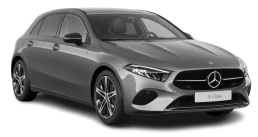
The A-Class
The Mercedes-Benz A-Class: What can we say other than what a truly amazing piece of automotive engineering.
The decision to get behind the wheel of a new car is a big one, and there is more to consider than the actual car. Transport is one of the highest areas of expenditure for Brits, with 14% of our income being spent on this; housing costs come a close second. If you’re in the market for a new car, it’s worth weighing up your options – and not just between makes and models. How you decide to get behind the wheel can have a massive impact on your pocket. Below we take a look at the pros and cons of owning a car, and the different ways to drive the car of your dreams.
If the idea of saving up tens of thousands for a new car is laughable, you’ll probably consider some sort of finance option. Personal Contract Purchase (PCP) is the most popular choice, although Hire Purchase (HP) and taking out a bank loan are also options.
PCP means you get behind the wheel for a fixed monthly payment. Similar to a lease agreement, you’ll be expected to pay an upfront fee, return the car in a good condition at the end of the period, agree to only travel a fixed number of miles each year and you might incur extra charges if you collect any bumps or scrapes. If you decide to keep the vehicle, you’ll need to make a final balloon payment.
HP, on the other hand, is a little more like a mortgage on a house. You pay an initial deposit and agree to pay the rest in monthly instalments – plus interest. Once everything is paid up, the car is yours, so there’s no need to worry about bumps and scrapes, the condition the back seat gets in when the children are eating ice-cream or a final balloon payment.
A bank loan is pretty similar to the HP option, except there’s no initial deposit. Travel as far and wide as you like, all the bank wants is the regular monthly payment, even if you write the car off and are left without wheels.
Owning a car means you’re liable for the cost of maintenance, repairs, insurance, road tax and if you decide to sell the car when you’re done (if it’s yours) you’ll also swallow the depreciation loss.
If you want to keep your monthly payments low and have no intention of driving the same car for the next decade, leasing could be the best and most cost-effective option for you.
Leasing a Mercedes-Benz C-Class Saloon over a three-year period costs around a third of what a PCP agreement would – and the restrictions are pretty much the same. However, with a lease agreement from Mercedes on Lease, you’ll also be covered for road tax, roadside assistance and have a warranty for the entirety of the agreement*.
Pros:
Cons:
Pros:
Cons:
2019 is the year that you’ll be able to get behind the wheel of one of the best prestige hybrid or all-electric vehicles. Already released are Mercedes’ E Class Hybrids with the E300e (petrol hybrid) and E300de (diesel hybrid) now available in both saloon and estate body styles. Still to come are the EQC – an all-electric SUV, the C Class plug, and A, B, GLC and GLE Class plugins. You can expect to see them by the end of this year. Next year will bring a pure electric version of the V Class, promising to challenge what drivers can expect from the MPV category.
While Mercedes-Benz has given drivers an electric option for their cars for the past five years, the newest additions to the range offer an all-electric commute to those wishing to reduce their emissions to zero.
The new E 300e has a four-cylinder petrol engine producing 208bhp and a 121bhp electric motor for a combined output of 315bhp and 700Nm of torque. This combination allows the E 300e to go from 0 to 62mph in just six seconds and reach a top speed of 155mph while emitting a trifling 45g per kilometre of CO2. The compact battery provides 30 miles of all-electric travel with the touch of a button and charges from 10% full to 100% in less than two hours using a 7.4 kW charger.
The diesel version of the Hybrid E Class is the most economical of all E Class vehicles – The 194bhp 2.0-litre turbodiesel engine is paired with a 122bhp electric motor and 13.5kWh battery, giving it 166.2mpg. It too can reach a top speed of 155mph and accelerates from 0 – 62mph in under six seconds.
Inside you can expect the high standard of luxury that’s synonymous with the Mercedes-Benz brand. You’ll be surrounded by high-quality materials, attractive finishes and advanced technology. The entry-level SE model comes with a widescreen display for car instruments and infotainment uses, front and rear parking sensors, electrically adjustable heated front seats and parking assistance features.
If you’re looking for a sportier style, opt for the AMG Line.
If you’re in the market for an entry-level Mercedes-Benz hybrid model, you’ve a little longer to wait. The A-Class is expected to go into production around the middle of the year. It’s rumoured to have an all-new plug-in hybrid powertrain and combine a 163bhp version of the marque’s 1.3-litre four-cylinder petrol engine with a 90bhp electric motor. The petrol engine is expected to throw power to the front wheels while the electric motor will provide drive exclusively to the rear wheels. This set-up provides four-wheel drive capability, giving the A Class an upgrade of more than just electric capability.
The EQC – Mercedes’ all-electric SUV – is arguably the most exciting addition for the manufacturer and will be the first dedicated electric Mercedes model to enter series production. With seating for five and 79 litres more luggage space than the GLC, the EQC will count versatility among its strongest selling points.
Powered by a newly developed electric drivetrain consisting of two electric motors – one powering the front wheels and the other the rear, this configuration enables four-wheel drive capability, depending on the driving mode. In Sport mode, the EQC can sprint from 0 to 62mph in just over five seconds and reach a top speed of 112mph.
The SUV doesn’t skimp on power either; it has a towing capacity of 1800kg and a 515kg payload. The range of 249 miles on the WLTP cycle, means the EQC should be able to traverse around 200 miles of real-world range per charge, making this the all-electric SUV to keep an eye out for.
If you believe the headlines in the papers, you may be anticipating the arrival of fully driverless vehicles on our roads at the end of the year. The UK government has already legislated for advanced trails of autonomous vehicles on our roads – but is the technology up to expectations?
To make a car truly autonomous and able to drive without any need for human intervention, a LOT of different technology is required. The vehicle needs to be able to ‘see’ and understand its surroundings – signs, traffic lights and road layout, to name just a few. It also needs to be able to regulate its speed, know where it is going and correctly identify obstacles like cyclists and pedestrians so it’s safe for passengers and other road users. With all of that input, the car needs to be able to make sound judgements that reduce the risk of accidents, if not eradicate them completely.
The DfT has also specified that driverless cars must also collect data such as speed, braking commands and the presence of other road users, so a high level of cybersecurity needs to be included in a driverless car’s technological stack to ensure cars can’t be ‘hacked’ and have their safety compromised.
At present, the technology required to enable truly autonomous vehicles – the kind that will drive you to work while you catch up on sleep or emails – just isn’t there, yet. No matter what the political will is, further development by car manufacturers and software houses is needed.
To understand how close, or how far away, we are from truly driverless vehicles, it is useful to understand the different levels of autonomy that need to be mastered before cars are able to do our bidding. SAE International, a global association of engineers and technical experts in the aerospace, automotive and commercial-vehicle industries have put together a handy guide on the five levels of autonomy and what they mean for a driverless future.
Starting at 0 – no automation and finishing at five – full automation, the path toward a driverless future includes four incremental steps. These steps are necessary for the development of the technology as well as wider public acceptance of it.
Driver assistance packages like cruise control are considered to be level 1. Level 2 – partial automation – involves both steering and speed being controlled by autonomous systems; like Mercedes-Benz’s Lane Keeping Assist, Reverse parking assist and Adaptive Cruise Control.
Level 3 is also referred to as partial automation but at a slightly higher level. The driving system needs to monitor the surroundings and respond to them in an intelligent way using Artificial Intelligence (AI). With level 3 autonomy, the human driver is only there to intervene should things go awry and this is where most testing is now taking place. Level 4 and 5 autonomous tech is yet to be released or reliably developed – neither requires the intervention of a human driver.
Given the scale of the technological task and where we currently sit within the levels of autonomy needed to see driverless car on our roads – either in a commercial or private capacity – it’s unlikely you’ll be commanding an AI Jeeves to take you to work, or drive your children to school by the end of 2021, but sometime between 2025 and 2030 you may well relinquish control to your car.
 Mercedes on Lease is a trading name of ACL Automotive Contracts Limited. Registered Office: The Carriage House, Maidstone, ME15 6YE. Registered in England & Wales with company Number: 06296885 | Data Protection No: Z100466X | Vat No: 338 855 754. ACL Automotive Contracts Limited are authorised and regulated by the Financial Conduct Authority, Registered No: 730720. ACL Automotive Contracts Limited are a credit broker and not a lender. ACL Automotive Contracts Limited work with a panel of lenders and we will receive financial remuneration which may be variable or pre-set dependent on the product and the volume that we place with that organisation. The amounts that we receive may vary. You will pay a fee for our services.
Mercedes on Lease is a trading name of ACL Automotive Contracts Limited. Registered Office: The Carriage House, Maidstone, ME15 6YE. Registered in England & Wales with company Number: 06296885 | Data Protection No: Z100466X | Vat No: 338 855 754. ACL Automotive Contracts Limited are authorised and regulated by the Financial Conduct Authority, Registered No: 730720. ACL Automotive Contracts Limited are a credit broker and not a lender. ACL Automotive Contracts Limited work with a panel of lenders and we will receive financial remuneration which may be variable or pre-set dependent on the product and the volume that we place with that organisation. The amounts that we receive may vary. You will pay a fee for our services.
© Mercedes On Lease. All rights reserved. Terms. Terms & Conditions. Customer Policy. Initial Disclosure. Complaints Procedure. Privacy Policy. Information Notice. Cancellation Policy. Commission Disclosure. Modern Slavery Statement. Support for Vulnerable Customers